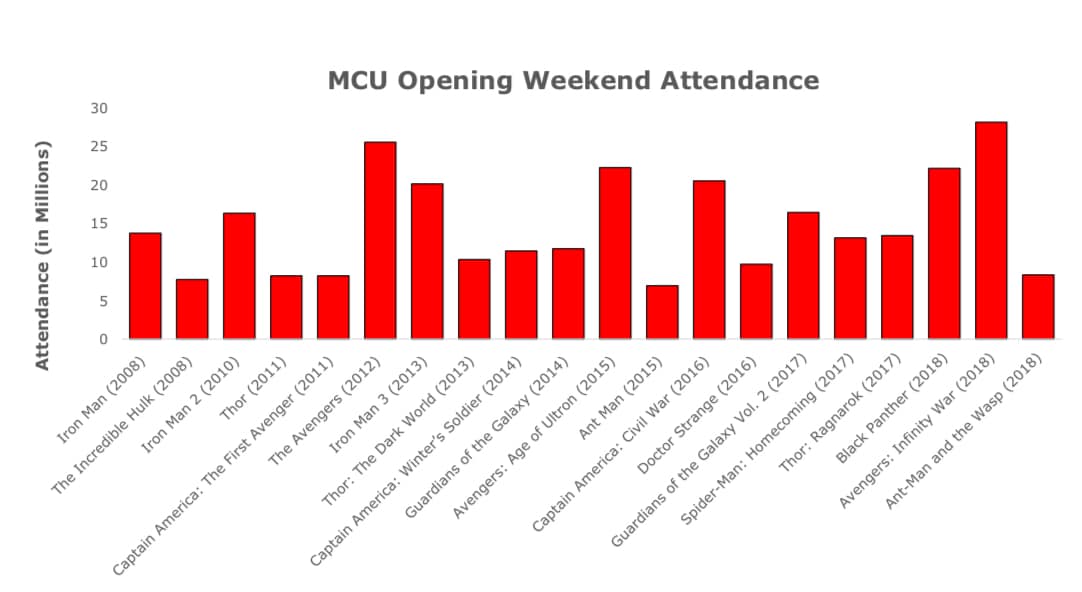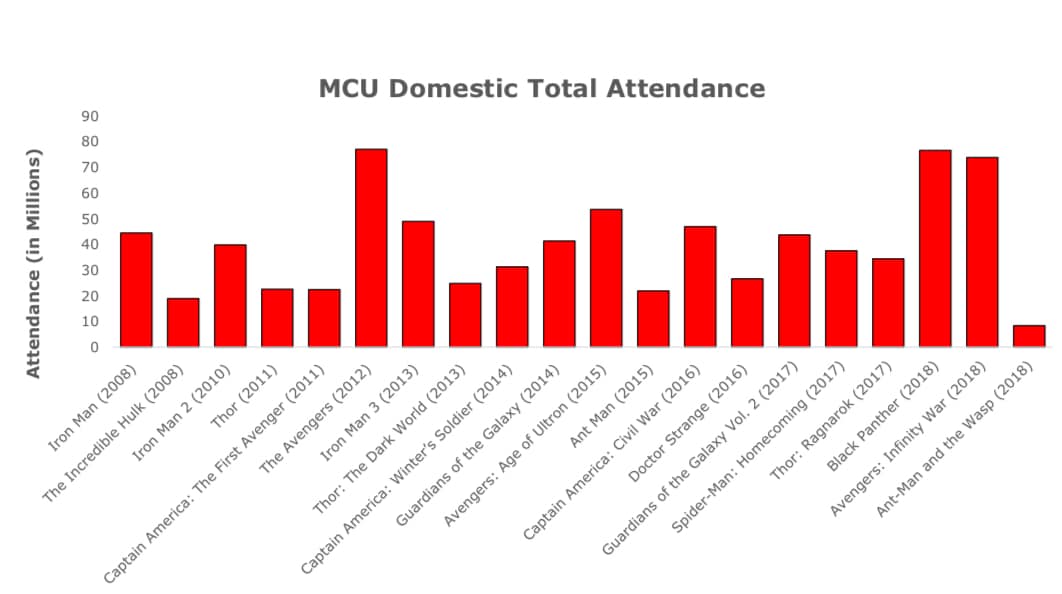Marvel continues to be immune to sequelitis with its individual series.
The first Ant-Man has the distinction of having the lowest opening weekend attendance of all of the Marvel Cinematic Universe movies. It’s also the lowest-grossing MCU installment overall in North America after The Incredible Hulk. Audiences just weren’t that interested in seeing Paul Rudd as a reluctant superhero with shrinking powers. Despite the fact that reviews were decent, albeit not as positive as most Marvel movies, and it received an ‘A’ grade from opening night audiences via CinemaScore polling.
In the three years since, Ant-Man must have found some additional fans, because its sequel did a whole lot better. Over the weekend, Ant-Man and the Wasp drew 8.3 million people to theaters, compared to the 6.9 million who went to see the original in July 2015. That’s still on the lighter side as far as MCU openings go — it’s the 16th best debut out of 20 releases and still the worst debut for a sequel, which makes sense analogously — but it’s also a 20% improvement as far as Ant-Man movies go.
Presumably, some of that increase in attendance is due to the title and the movie itself showcasing the Wasp. She’s the first female superhero to at least share top billing in a Marvel Studios production, and possibly as a result of that, the audience for Ant-Man and the Wasp was reportedly 45% women compared to Ant-Man‘s audience being only 42% women. Or, maybe this is just a standard evolution for Marvel movie attendance. For the most part, especially for the “solo” Avengers offshoots of the franchise, sequels draw a bigger crowd.
Here is a break down of each individual series of the MCU by opening weekend attendance:
Iron Man: 13.7 million
Iron Man 2: 16.3 million (19% increase over the original)
Iron Man 3: 20.8 million (52% increase over original; 28% increase over the last)
Thor: 8.2 million
Thor: The Dark World: 10.3 million (26% increase over the original)
Thor: Ragnarok: 13.4 million (63% increase over the original; 30% increase over the last)
Captain America: The First Avenger: 8.2 million
Captain America: The Winter Soldier: 11.4 million (39% increase over the original)
Captain America: Civil War: 20.5 million (105% increase over the original; 80% increase over the last)
Guardians of the Galaxy: 11. 7 million
Guardians of the Galaxy Vol. 2: 16.4 million (40% increase over the original)
The Avengers: 25.5 million
Avengers: Age of Ultron: 22.2 million (13% decrease from the original)
Avengers: Infinity War: 28.1 million (10% increase over the original; 27% increase over the last)
Ant-Man: 6.9 million
Ant-Man and the Wasp: 8.3 million (20% increase over the original)
Only one sequel in the entire MCU sold fewer tickets in its debut than its direct predecessor: Avengers: Age of Ultron. And only one sequel increased at a lower rate than Ant-Man and the Wasp: Iron Man 2.

If it weren’t for the slight improvement on drawing a female audience, the latest might have also had the worst increase in ticket sales overall. How did its draw of women moviegoers compare to the rest of the Marvel movies, though? Another breakdown:
Ant-Man and the Wasp (2018): 45%
Black Panther (2018): 45%
Guardians of the Galaxy (2014): 44%
Guardians of the Galaxy Vol. 2 (2017): 44%
Thor: Ragnarok (2017): 44%
Ant-Man (2015): 42%
Avengers: Infinity War (2018): 42%
Avengers: Age of Ultron (2015): 41%
Spider-Man: Homecoming (2017): 41%
The Avengers (2012): 40%
The Incredible Hulk (2008): 40%
Iron Man 2 (2010): 40%
Doctor Strange (2016): 39%
Iron Man 3 (2013): 39%
Thor: The Dark World (2013): 38%
Thor (2011): 37%
Captain America: The First Avenger (2011): 36%
Captain America: The Winter Soldier (2014): 36%
Iron Man (2008): 35%
Captain America: Civil War (2016): 34%
Not only does the MCU seem to be appealing to women more and more over time, for the most part, but this year’s Ant-Man and the Wasp and Black Panther are likely both at the top of this chart due to their increased focus on women characters. There is no doubt that Marvel’s next release, to solo female superhero film Captain Marvel, will bring an even greater balance of women moviegoers (DC’s solo female superhero film, Wonder Woman, had an opening weekend audience that was 52% women). Of course, that doesn’t mean a bigger crowd overall.
In fact, how Ant-Man and the Wasp continues to perform will be interesting to see, because there’s a chance its final domestic attendance is not as great compared to the original as its opening weekend seems to promise. Ant-Man and the Wasp is the only “solo” MCU series sequel to receive a lower grade via CinemaScore than its predecessor(s), with only an ‘A-‘. The Avengers movies have also seen a decrease from the original’s ‘A’ to the two others’ ‘A’ grade. All other series have been level or saw an improvement in first-night reactions.
Ant-Man and the Wasp also saw the largest frontload of any of the MCU installments so far. The sequel’s audience on Friday (including Thursday previews), which was 3.7 million, made up 44.5% of its weekend total. That tops the figure of the disappointing first Avengers sequel, Age of Ultron, attendance for which was frontloaded on Friday to the tune of 44.1%. More recently, Spider-Man: Homecoming also saw a frontloaded crowd, bringing in 43.4% of its opening weekend crowd on Friday. Avengers: Infinity War‘s was 41.2%; Black Panther‘s was 37.6%.

The post ‘Ant-Man and the Wasp’ Draws a Bigger Crowd Than ‘Ant-Man’ (Especially With Women) appeared first on Film School Rejects.
No comments:
Post a Comment